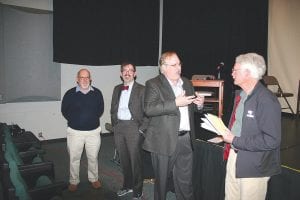Minnesota’s property tax—with 55 classes of property—is among the nation’s most complex, said Aaron Twait.
Twait, of the Minnesota Center for Fiscal Excellence (MCFE) and Cook County Assessor Todd Smith, were the featured speakers for the Tuesday, April 4 Cook County Chamber of Commerce sponsored seminar “How the Property Tax works.” The meeting was held at the Arrowhead Center for Arts and underwritten by North Shore Title and Voyageur Brewing Company. About 50 people attended.
MCFE has bee around for 91 years. It used to be called the Minnesota Taxpayers Association. It is non-partisan, and its longstanding mission is to advocate for sound tax policy and efficient, accountable government. MCFE provides state and local decision makers with objective analysis about impacts of spending and tax policies.
“Fiscal Excellence,” said Twait, consists of three simple yet fundamental ideas. First, revenue collection should reflect the principles of sound tax policy. Second, government spending should be transparent, efficient, and accountable and third, spending should be measured and evaluated. Because of the complexity of Minnesota’s tax system, Twait said when any one of the three was simplified; the other two were made more complicated.
Cook County, with 92 percent of its property in the hands of the state or federal government, relies on cabin owners to pay 45 percent of its property taxes, which is the highest in the state, said, Twait. Most counties received about three percent of their property taxes from seasonal home/ cabin owners, he added. “If you have a lot of absentee landowners,” said Twait, and cabin values drop, and their taxes go up, local decisions on how to spend those tax dollars should be made carefully. Cabin owners, however, don’t get taxed for the school, so when a school levy passes, that is not included on their bill, he added.
“Values go up; taxes go down. Taxes go up, values go down,” which confuses property owners, said Twait. “The bad news is if you want to understand your taxes, go through all of the lines on your tax bill.”
The state of Minnesota tries to keep its property tax formula geared to taking two to three percent of every property owner’s income, regardless of how much they make. There are a variety of programs aimed at keeping homeowners who have little income in their homes, he said.
The best way to understand what your future property taxes might be is to get involved in the counties’ budget process, Twait said.
Cook County Assessor Todd Smith gave an overview of his office and the assessment process.
Cook County has about 12,000 properties, but the three-person assessor’s office looks at and records 9,500.
Smith said the state of Minnesota started cracking down on counties who weren’t physically visiting and assessing 20 percent of their properties each year. Cook County is in the fifth year of completing its “quintile,” which was started by Smith’s predecessor Betty Schultz. Had Cook County not taken up the quintile, Smith said because the county was out of compliance, the state promised it would come in and complete the work for $250,000 if the county didn’t do it.
Because some properties haven’t been assessed in a long time, Smith said many owners were shocked and angered when they got their most recent tax bill.
One place that was visited was supposed to have six structures on it, and it had 12. The six additional structures were classified as “new,” and the property owner was assessed for those additional “new” buildings. Even if a garage or workshop or addition had been there for 10 years, the assessor’s office has to call it “new” because it has never been taxed before, said Smith. He said his office had found some places that haven’t been visited by a county assessor since the late 1990s. Once the quintile process is complete, Smith said taxes wouldn’t spike the way they have for the last four years.
The state statutes require the assessor’s office to revalue property every year to reflect real estate market conditions. “We are required to make sure assessment values are between 90 percent and 105 percent of actual market value,” Smith said. Additionally, said Smith, someone from the office will inspect property every five years.
Valuations are based on land size, quality, and conditions of improvement and assessed values of comparable properties and property classifications are based on the most current use of the property.
Last year there were 17 home sales in Grand Marais so that greatly aided the assessor’s office in determining home values nearby, he said.
Because of the quintile system, the county has gained $17 million in value. That makes it fairer for all property owners by spreading the taxes out, Smith said.
“We want to ensure fair and equitable treatment of all property owners in Cook County and ensure that all property owners pay no more than their fair share of the property tax,” he said.
One resident and one business owner have taken Cook County to tax court, but Smith said it is a long, arduous process that takes three years to complete and is very expensive.
If you have any questions about your valuation, Smith encourages you to contact the assessor’s office.



Loading Comments